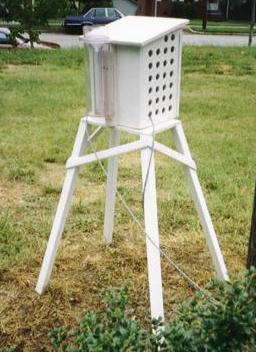Weather Instrument Shelter
by Rod Gonski
For long-term exposure of weather instruments of the non-electronic local readout type, it is advised that they be housed in a proper weather instrument shelter. An example of a weather instrument shelter, pictured below, houses a maximum/minimum thermometer and also supports a 3-inch diameter cylindrical rain gauge on the back side of the unit. It is made entirely of wood and is attached with screws, nails, a few corner braces, and 2 hinges. It also has locking hardware and is fitted with a locking cable to help secure the shelter outdoors.
It is important that weather instruments inside the unit have adequate natural ventilation. The instruments should be at a level of 4 to 4.5 feet above the ground. The shelter door should face north so that sunlight will not directly shine on the thermometer when the door is opened. Built to the specifications below from new materials, the estimated cost of the shelter and security hardware is $30 excluding labor and instruments. Max/min thermometers cost $15-25, and rain gauges, $8-$12.

Suggested dimensions/specifications:
Inside--
11.25" deep x
15.00" wide x
15.00" tall in back x
17.50" tall in front
Double sloping roof with airflow in between roof panels. Roof top, 16"x 23.5".
Floor slats are spaced 0.5" to 1" for ventilation. Louvered side panels and door are preferred. But 1" thick panels drilled with several 1" holes slanted down toward the outside are adequate.
The back panel should be solid. A T-shaped strut should be installed near the center inside to hang the thermometer.
All surfaces should receive 3 coats of white paint.
Exposure and Location of Weather Instruments
Compiled by Phil Duncan and Rod Gonski
The following guidelines for proper exposure and location of weather instruments are for the ideal arrangement. Your individual situation may not allow you to follow all the rules. But please keep in mind that the thermometers must be located in the shade, and try to locate them away from buildings or other heat sources. Do the best you can.
Thermometers
Thermometers should be shielded from the sun, rain, snow and other sources of light, heat, or cold that can cause erroneous readings. If an instrument shelter is used, it should be designed to allow the maximum possible free flow of air while providing protection from heat, precipitation and light. A shady location on the northeast side of the school is a preferred site.
The thermometer should be 4.5 to 6 feet above the ground and in a grassy location. (You may need to keep a step stool nearby for short people because readings are taken at eye level to minimize parallax error.) A flat, open clearing is desirable so that the thermometer is freely ventilated by the flow of air. Stay at least 100 feet away from concrete or paved surfaces. Avoid balconies, patios, enclosed porches, and beneath eaves.
Precipitation Gauges
The exposure of a precipitation gauge is important for obtaining accurate measurements. Avoid obstructions such as trees or buildings that may deflect the fall of precipitation and cause turbulence. The gauge should be over level ground and at least twice the distance away from trees and buildings as they are tall. For example, the gauge should be at least 40 feet away from a 2-story (20-foot tall) building.
Though a precipitation gauge should be located away from obstacles, it should not be in an elevated site or in areas of channeled winds (ie in a passageway between buildings). As a general rule, the windier the exposure is, the greater the precipitation measurement error will be. Also, to avoid collecting back splatter, the top of the gauge should be at least three feet above the ground.
